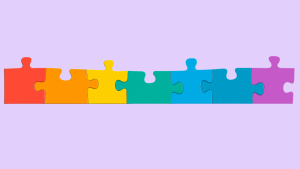By Carolyn DeBarra
As a writer with Attention Deficit Hyperactive Disorder (ADHD), I spend a lot of my days explaining my condition, detailing my ‘symptoms’ or writing about the unusual path I have taken to medication – medical cannabis. My aim has always been to shine a light on neurodiversity and make people feel a little less alone in their diagnosis journey than I did when I started mine.
I’m not alone in this as there has been a huge increase in the visibility of ADHD online. Social media, magazine articles, and celebrities sharing their stories have increased the number of people seeking a diagnosis. So much so that the NHS and private practices are struggling to cope with the number of people looking for answers.

This inevitably has reached a fever pitch among curious columnists who are quick to dismiss ADHD as another ‘trend’. Many have shared their views on how putting down our phones would help or that the diagnostic criteria are too vague that everyone on some level qualifies.
It’s frustrating that so many people without knowledge of my disability get a national platform (think Telegraph, BBC, Sunday Times among others) to discuss it. I am appalled that dumping on disability has been given such an airing, but publications have been quick to ignore pitches on the positives of ADHD life.
I was diagnosed at ten years old and have grown up with the knowledge of being neurodivergent. While there are positives to being ADHD, there have been limitations, negatives, and frankly traumatic experiences that I’m still unravelling. But yet, according to one columnist, I have the ‘must-have mental health condition’ of the season.
The reason that many people are rushing to get a diagnosis is that it hasn’t been an option for them before now. ADHD can be masked or misdiagnosed very easily so many people have always known there is something, but haven’t had the words to describe it. Visibility of mental or physical health conditions is a good thing because it means it increases awareness.
Don’t get me wrong – there are negatives to increased awareness. Some social media posts make me gasp because they are so unsafe or contain misinformation. But for the most part, I’m all for someone sharing their journey or asking for help. The more people are aware then the more I can ask for help at work or in a relationship where I don’t have to exhaustingly explain ADHD for the millionth time.
The language used to discuss ‘this ADHD nonsense’ by these columnists is nothing new as they are quick to get their clickbait titles in. According to them, it’s an ‘epidemic’ of people looking for a diagnosis and ‘all this ADHD doesn’t add up.’
We understand a lot of things in terms of a spectrum, think of sexuality and gender as two very complex things. I always thought of neurodiversity in the same way in that we have been far too quick to label people ‘neurodiverse’ or ‘neurotypical’ and expect people to fall neatly into one category or the other. I think, if we stop to examine it, a lot more people will be neurodiverse in some way than we expect so no wonder some of these ADHD TikToks are hitting home for folks.

Also, age is a consideration in this as well because there is an entire generation of older people for whom diagnosis was not an option. I was diagnosed in 1996 and that was a rare thing but it was right as ADHD was becoming a more well-known condition. My mother, who is now in her 60s, reckons that she would have been diagnosed when she was a child, should that have been an option for her. It just wasn’t so now we have a wave of older folk seeking the diagnosis that they feel they missed as a child.
Gender also plays a part in this as well since women and girls spent a lot of time being missed out on ADHD or autism diagnoses. The criteria for diagnosis was based on boys and men but it is thought that women and girls present very differently. A lot of ADHD diagnoses were missed by chalking girls’ behaviour down to being a bit ‘scatty’ or ‘dreamy’. So now, the women and girls are making up for lost time by demanding to take control of their health.
There is also absolutely nothing out there for the transgender community who are also looking for a diagnosis. Almost all of the studies and books focus their efforts on dividing their participants into neat boxes labelled ‘women’ or ‘men’ while ignoring an entire community of trans and non-binary people in the process.
So in being quick to label this – a trend – the columnists are ultimately showing that they know nothing about this condition. If they bothered to look, they will see early studies, books, and information because we’ve always been here. But then, what is actual research when you have to get those valuable clicks in?
Keep up to date with all Enhance The UK’s top tips by following us on twitter @EnhanceTheUK. If we can help with training, access audits or general enquiries please do get in touch.



